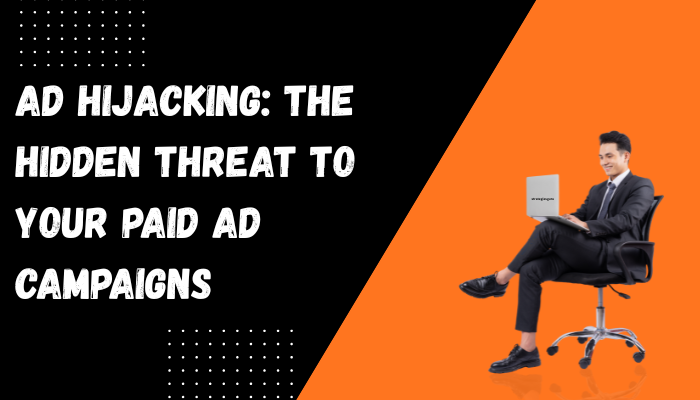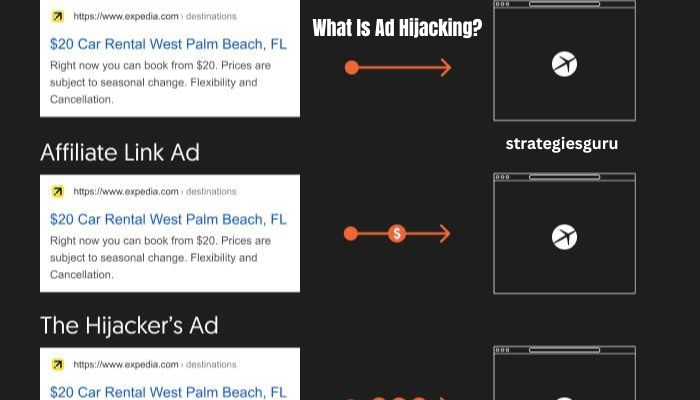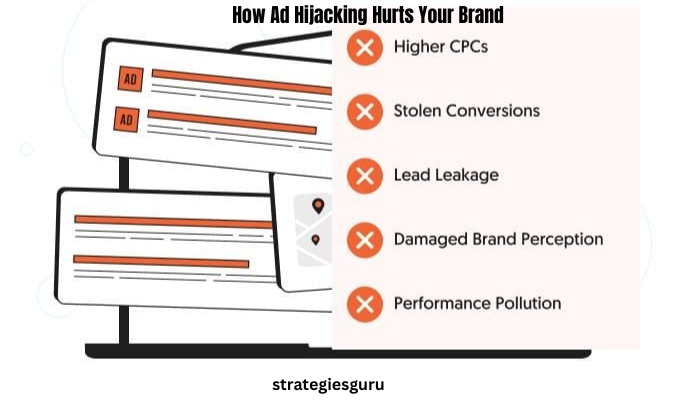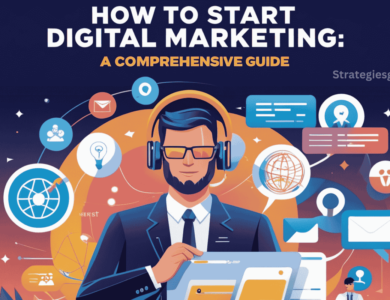Ad Hijacking: The Hidden Threat to Your Paid Ad Campaigns

Ad hijacking is one of the most overlooked threats in paid media. Hijackers often create their own media or copy that mimics your ads. In many cases this is hard to spot, but on social media it is more obvious (e.g. logos or branding look odd, creatives seem cheap or rushed, etc.). Most marketers don’t even realize this is happening. And by the time they realize it, a lot of damage has already been done: CPCs (cost per click) go up, leads are stolen, and the overall campaign performance becomes so complicated that it becomes difficult to understand. In this post, we’ll explain how ad hijacking works, why it’s so hard to spot, and most importantly — how you can protect your brand so you don’t waste another click.
Contents
Key Takeaways
- Ad hijacking degrades campaign performance and returns on investment (ROI), Because it intercepts high-intent branded traffic, inflate costs per click (CPCs), and misattribute conversions – all without any obvious red flags.
- Affiliate partners are responsible for up to 75% of ad hijacking. They take advantage of gray areas in tracking and enforcement to earn unauthorized commissions and corrupt your paid media data.
- The financial and strategic impact adds up over time — starting with wasted ad spend, and extending to long-term damage to data accuracy, attribution modeling, and brand trust.
- Operational readiness is essential to prevent hijacking — including strong affiliate controls, playbooks, automated detection tools, and performance audits that should be part of your paid media routine.
What Is Ad Hijacking?

Ad hijacking occurs when unauthorized third parties copy your paid ads — often word for word — and divert traffic that should be for you to their own landing pages. These people typically bid on your branded keywords, making users think they’re clicking on your ad when they actually aren’t. The most frustrating part is that the hijacking often happens undetected. Your metrics may look fine on the surface, but in reality, your clicks and conversions are being stolen. So now the question arises — who is behind these lookalike ads and what do they gain from it? Let us now understand these potential culprits in detail.
Who is Behind Ad Hijacking?
These people are responsible for about 75% of hijacking cases. Some affiliate partners handle their advertising responsibly, but others bid on your branded keywords, copy your ads, and earn commissions on the traffic that should have actually come to you — instead of bringing in new traffic. In many cases, your competitors are behind the hijacking, deliberately stealing your traffic to increase their profits. Sometimes this hijacking also happens by mistake — such as due to dynamic keyword insertion. In this, a competitor bids on your branded keywords, and the ad platform automatically adds headlines. Because of this, sometimes your brand name is also included in the ad copy by mistake.
How Does Ad Hijacking Work??
Ad hijacking begins when someone — usually an affiliate — bids on your branded keywords. They copy your ad copy so closely that it’s hard to tell the difference between the real ad and the fake one. When a user clicks on that hijacked ad, they land on a website that’s controlled by the hijacker. That site either redirects them back to your website (so they can earn a commission), or diverts the traffic to another offer or to a competitor’s website.
What Makes Ad Hijacking So Hard to Spot?
Ad hijacking is a fraudulent process that is intentionally designed to work in a limited number of locations. Hijackers often use geo-targeting so that their fake ads only appear in a limited number of locations. So you may never see the fake ad unless you search from a specific location. They may rotate their campaigns, run ads at odd times, or use cloaking — showing one thing to regular users and another thing to brand monitors. To the average user, there are no obvious warning signs. The ad copy looks familiar, and the destination page may even be your website — it just goes through an affiliate link. Advertisers can’t monitor every impression or every bid. And that’s why hijackers thrive. Now let’s see what this looks like in the real world.
A Real Ad Hijacking Example
Let’s talk about an audit we conducted for AARP. On the surface everything looked normal, but when we dug a little deeper, a shocking level of ad hijacking was discovered.
Just a simple search of Meta’s ad library revealed over 100 ads being run by affiliates for AARP-branded products. You can see some examples here: All of these ads redirected us to the websites of third-party insurance providers such as Surf Tags, Urban Market and Consumer’s Buzz. On the surface, it’s not uncommon for third-party providers to promote branded products in the insurance industry. But we had to make sure these accounts weren’t spammy or negatively impacting our ad performance. To confirm this, we dug deeper into the sources of these ads:
A common sign of fraudulent marketing strategies is the profile of the brands being used. If a business is not legitimate, its profile is usually new or has very few followers. If you find these types of profiles while doing research, you can report them to Meta or whatever platform you are using.
Ultimately, we came to the conclusion that these AARP ads were in fact cases of ad hijacking. When we contacted the client, it was clear that they had no association with the affiliates mentioned above. Even at the search level, these profiles were not associated with AARP and this appeared to be a case of dynamic keyword insertion — where a competitor targets our brand name as a keyword and uses dynamic headlines in their ad copy.
How Ad Hijacking Hurts Your Brand

- Higher CPCs
When hijackers bid on your branded keywords, the auction price automatically goes up. Even if you win the bid, you have to pay more for each click — just to compete with people who are targeting your same brand terms. These increased costs add up quickly, especially when your campaigns are running at high-volume.
- Stolen Conversions
Many times affiliates or competitors claim conversions that were supposed to go to your website anyway. This causes you to lose clarity of attribution. In affiliate cases, redirect links lead traffic to the affiliate’s checkout page, earning them a commission that should actually have been added to your earnings.
- Lead Leakage
When hijacked ads send to an unrelated or low-quality landing page, valuable leads are either lost or difficult to track. This not only leads to a loss of potential revenue, but also makes it nearly impossible to accurately evaluate your campaign performance.
- Damaged Brand Perception
Hijacked ads can lead users to misleading, irrelevant, or even fraudulent offers. If the user has a bad experience, they blame your brand instead of the hijacker. This directly impacts brand trust and credibility, even if you didn’t authorize the ad.
- Performance Pollution
Ad hijacking corrupts your campaign data — metrics like CTR, ROAS, and conversion attribution get distorted. When the analysis is wrong, performance optimization gets confused too. You make decisions based on signals that aren’t real.
How to Spot Ad Hijacking
Ad hijacking tactics are often very silent and subtle, making them difficult to spot in time. Additionally, you need to keep an eye out for two types of hijacking: affiliate and competitor. Competitor hijacking is just as the name suggests — when your competitors bid on the same keywords as you. Affiliate hijacking is done by businesses who list products or services on their website using redirect links so they can earn commissions. Depending on your industry or product, this can seriously harm your marketing effectiveness. An easy way to spot this is to type your branded keywords into the ad platform’s search bar. We did this for AARP and found over 100 ads running on Meta under the brand’s name. This level of hijacking can undermine your entire marketing strategy. Regardless of the type of hijacking you are facing, below are some proven and effective strategies that will help you identify and stop it in time — before it harms your campaign.
- Conduct Regular Ad Copy and SERP Audits
Manually search for your branded keywords and inspect the ads that are showing up. Look for ads that match or are too similar to your ad copy. If an ad is redirecting to an unknown domain or looks suspicious, it could be a case of hijacking. In-platform tools like Meta Ad Library can help you easily conduct an audit. You can search for any ad related to branded and non-branded keywords and detect any spam or unauthorized campaigns.
- Use Monitoring Tools
Platforms like Adthena, BrandVerity, and The Search Monitor specialize in identifying unauthorized ads. These tools scan SERPs in different locations and time zones and uncover copycat ads that you might not catch manually. They also help record and document violations.
- Watch for Performance Anomalies
If you notice a sudden drop in your conversion rate, an unusual increase in CPC, or strange changes in affiliate traffic, it could be a sign that someone else is intercepting your clicks.
If performance suddenly drops and there’s no obvious reason, investigate deeper.
- Analyze Affiliate Conversion Patterns
If you work with affiliate partners, keep track of when, where, and how each conversion happened. A sudden spike in one area, a rise in conversions on branded keywords, or an increase in affiliate traffic without reason could all be signs of hijacking.
- Set Up Geo-Testing
Many hijackers target their ads to specific geographic regions so they don’t get noticed. If you’re running international campaigns, use a VPN or third-party tools so you can check SERPs from different locations.
- Review Search Impression Share
If your branded keywords’ impression share is dropping without any budget cuts or strategy changes, it could be a sign that someone else is aggressively bidding on your brand. Ad hijacking is often in plain sight, but these strategies will help you spot red flags quickly — and prepare to protect yourself instead of just reacting.
How to Stop (and Prevent) Ad Hijacking
Spotting ad hijacking is only half the battle. Once you’re sure it’s happening — or if you want to be prepared for it in advance — you’ll need a multi-layered protection strategy. Here’s how you can stop this pitfall and avoid future losses:
- Tighten Affiliate Contracts
If you work with affiliate partners, review your contracts immediately. Make sure they clearly state they won’t bid on your branded keywords, or copy your ad creatives. Also include a definition of ad hijacking in the contract and clear penalties in the event of a violation.
- Implement Monitoring Tools
Don’t rely solely on manual investigations. Use the technology of PPC tools to quickly identify and stop ad hijacking. Some tools even provide automated alerts and takedown request templates, making action quick and easy.
- Build an Internal Response Process
Have a clear workflow in place that defines what to do when ad hijacking is identified. Who will gather evidence? Who will contact the affiliate? Who will file a complaint? The faster your team can take action, the less damage your campaign will suffer. Regular audits via a monitoring tool or third-party scans, either monthly or quarterly, are also important.
- Optimize Your Campaign Settings
Optimize your campaign settings to make ad hijacking harder. This will ensure your ads target only the keywords you choose. Strengthen geo targeting and device targeting to block spammy affiliate ads from overseas. Monitor impression share on your branded keywords — to make sure hijacked ads aren’t driving it up unnecessarily.
- Educate Your Team and Stakeholders
Many times paid media teams are so focused on performance metrics that they overlook ad integrity. Hold training sessions to show the team what ad hijacking is, how it happens, and what role each team member can play in detecting or reporting it. Make it clear to the team: this isn’t just a traffic issue — it’s a brand safety issue.
- Use In-app protections
The platforms you use can also help prevent ad hijacking. Google allows you to report trademark infringement through their representative or support portal. TikTok (which is now a rapidly growing paid ad platform) and Meta also offer options for reporting trademark violations. Meta’s Brand Protection Tool is a huge help here. This is important because hijackers often create and run hundreds of ads simultaneously across platforms. When one ad is shut down, they immediately create another. It’s important for marketers to fully understand all the features of the platforms they’re using. With ad hijacking becoming a common problem, knowing how your platform can help you combat it is just as important as knowing its metrics and ad capabilities.
- Consider Agency Support
If your team doesn’t have enough resources or expertise to monitor threats 24/7, consider partnering with a paid media agency that specializes in affiliate management and brand safety. Such agencies have comprehensive monitoring tools, legal support, and effective implementation strategies. Preventing ad hijacking requires constant vigilance, but the effort is well worth it. The sooner you implement security, the more invisible pitfalls you’ll avoid.
How Agency Partners Can Help
Ad hijacking is complex, fast-moving, and easy to miss—especially for in-house teams juggling multiple priorities. That’s where agency partners can offer real value. Ad hijacking is complex, fast-moving, and easy to miss—especially for in-house teams juggling multiple responsibilities. That’s where agency partners can offer real value. Experienced agencies have specialized tools and expertise that are often not available to internal teams. From real-time monitoring platforms to built-in response workflows, these agencies help you identify and handle hijacking in a timely manner—so your campaign doesn’t suffer. These agencies also keep a close watch on affiliate partners—ensuring that partners follow the rules, and that any wrongdoing can be flagged immediately. If action is needed, agencies have direct connections with ad platforms, making takedowns quicker. Most importantly, these agencies take a proactive approach. They regularly audit campaigns, review branded keyword performance, and help you create long-term security strategies that align with your business goals.
When you work with a strategic partner, you don’t just solve problems — you prevent them from happening in the first place. That foresight can be the difference between a leaking media budget and a profitable scalable campaign. If ad hijacking has ever slipped your attention, be sure to ask these questions: “Do we have the right tools and time to catch it early — or is it going to cost us more?”
FAQs
1 What is affiliate ad hijacking vs. competitor hijacking?
Affiliate ad hijacking is when someone not affiliated with your affiliate program (or a website with no direct relationship to you) copies your ads, bids on your branded keywords, and earns commissions on traffic they did not actually generate. This violates the affiliate agreement and also distorts your performance data. Competitor hijacking, on the other hand, is even more aggressive — sometimes it can happen accidentally (such as through dynamic keyword insertion), but often your direct competitors will copy your ads to redirect traffic to their own website. This steals you conversions, leads, and market share, while also reducing your brand’s search visibility and trust.
- Can ad hijacking impact SEO rankings?
Ad hijacking doesn’t directly affect your SEO rankings, but it can indirectly. Hijacked ads often redirect to off-brand or spammy pages, confusing users and increasing bounce rates or reducing engagement. This affects trust signals like brand search and click-through rate (CTR), which Google pays attention to. If a hijacker uses black hat techniques, your domain could also be mistakenly linked to them.
- How much revenue can brands lose to ad hijackers?
The revenue lost can vary, but it adds up quickly. Hijacked ads often steal high-intent clicks — especially from branded search terms, which usually convert well. If you’re paying for those clicks — or worse, paying commissions on them — you could be losing thousands of dollars each month without even knowing it. For big brands, this annual loss can reach millions to billions. And aside from the direct loss of revenue, hijacking also dirtys your data and increases the cost of customer acquisition.
- Are there free tools for small businesses to monitor hijacking?
Yes — there are some free or low-cost tools available. The easiest you can start with is Google’s Ad Preview Tool, or setting up Google Alerts for your branded keywords. Meta’s Ad Library is also a quick and easy way to find hijacked ads. SERP Woo offers limited free SERP tracking. Tools like Adthena and BrandVerity offer free trials or demos so you can monitor in-depth. You can also catch geo-targeted hijacking by viewing search results from different locations using browser VPNs (like TunnelBear).
Conclusion
Ad hijacking can be a silent and persistent threat to your paid media performance. It slowly drains your budget, steals your conversions, and damages your brand credibility. And worst of all, most teams don’t realize it’s happening until the damage is already done. It doesn’t matter if it’s an affiliate abusing your systems or a competitor hijacking your branded keywords — the impact is very real: increased CPCs, corrupted data, and lost revenue opportunities. That’s why it’s so important to understand ad hijacking and take steps to prevent it. Tightening affiliate agreements and using brand monitoring tools will improve your ads’ visibility and data insights — and put you on the path to safety. Additionally, it’s a smart move to perform proactive auditing, enforce ad platform policies, and seek agency support when your team doesn’t have adequate resources or tools. As AI, automation, and affiliate networks become more complex, the potential for abuse is also growing exponentially. Now is the time to create a strategy that doesn’t just react, but actively defends against ad hijacking.

